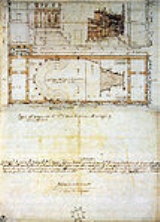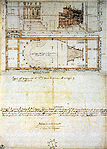
Teatro all'antica
Encyclopedia

Sabbioneta
Sabbioneta is a town and comune in the province of Mantua, Lombardy region, northern Italy. It is situated about 30 km north of Parma, not far from the northern bank of the Po River...
, northern Italy
Italy
Italy , officially the Italian Republic languages]] under the European Charter for Regional or Minority Languages. In each of these, Italy's official name is as follows:;;;;;;;;), is a unitary parliamentary republic in South-Central Europe. To the north it borders France, Switzerland, Austria and...
; it was the first free-standing, purpose-built theater in the modern world. The Teatro all'antica is the second-oldest surviving indoor theater in the world (after the Teatro Olimpico
Teatro Olimpico
The Teatro Olimpico is a theatre in Vicenza, northern Italy: constructed in 1580-1585, it is the oldest surviving enclosed theatre in the world. The theatre was the final design by the Italian Renaissance architect Andrea Palladio, Renaissance, and was not completed until after his death...
in Vicenza
Vicenza
Vicenza , a city in north-eastern Italy, is the capital of the eponymous province in the Veneto region, at the northern base of the Monte Berico, straddling the Bacchiglione...
), and is, along with that theater and the Teatro Farnese
Teatro Farnese
Teatro Farnese is a Baroque-style theatre in Parma, Italy. It was built in 1618 by Giovanni Battista Aleotti. The theatre was almost destroyed by an Allied air raid during World War II...
in Parma
Parma
Parma is a city in the Italian region of Emilia-Romagna famous for its ham, its cheese, its architecture and the fine countryside around it. This is the home of the University of Parma, one of the oldest universities in the world....
, one of only three Renaissance theaters still in existence.
History
The theater was constructed in 1588 and 1590 by the celebrated Vicentine architect Vincenzo ScamozziVincenzo Scamozzi
thumb|250px|Portrait of Vincenzo Scamozzi by [[Paolo Veronese]]Vincenzo Scamozzi was a Venetian architect and a writer on architecture, active mainly in Vicenza and Republic of Venice area in the second half of the 16th century...
under a commission from Duke Vespasiano I Gonzaga
Vespasiano I Gonzaga
thumb|250px|Vespasiano I Gonzaga.Vespasiano I Gonzaga was an Italian nobleman, diplomat, writer, military engineer and condottiero...
, as part of Gonzaga's effort to turn his tiny Ducal seat into an idealized classical city. The importance that theater had come to hold, as a sign of the civilized society that the Duke was trying to create, is indicated by the prestigious location that was reserved for the theater in the principal street of the town, the Via Giulia, and by the fact that a separate building was erected to hold the theater. This prestige location had a cost, however, in the form of a cramped and narrow setting that could be successfully converted into a theater only by the considerable ingenuity of one of the Renaissance's most gifted architects.
The influence of the Teatro Olimpico upon the Teatro all'antica is evident in a number of features—most notably in the colonnade at the rear of the seating area and in the set designs. Such influences are to be expected; Scamozzi had overseen the construction of the Teatro Olimpico following the death of the great Andrea Palladio
Andrea Palladio
Andrea Palladio was an architect active in the Republic of Venice. Palladio, influenced by Roman and Greek architecture, primarily by Vitruvius, is widely considered the most influential individual in the history of Western architecture...
, who had laid out its original design. In particular, Scamozzi had been responsible for the remarkable perspectives which form the onstage scenery at the Teatro Olimpico.
However, the Teatro all'antica was a much different theater, in part because of the different building in which it was placed, and in part because Scamozzi had learned important lessons as a result of his labours at the earlier theater. The theater building is roughly three times as long as it is wide, whereas the space occupied by the Teatro Olimpico is approximately square. The longer, narrower structure of the theater building meant that Scamozzi was unable to build the seating area in the form of the semicircle that had been seen by Palladio as the ideal form for an audience, based on the model of ancient Roman theaters. Where the wide, shallow space available in the converted building that was used to house the Teatro Olimpico had forced Palladio to stretch the ideal semicircle into an ellipse, the opposite change was forced upon Scamozzi in Sabbioneta, and the seating area was transformed into a horseshoe.
As well, Scamozzi abandoned completely the elaborate and classically-inspired scaenae frons
Scaenae frons
The scaenae frons is the elaborately decorated background of a Roman theatre stage. This area usually has several entrances to the stage including a grand central entrance. The scaenae frons is two or sometime three stories in height and was central to the theatre's visual impact for this was what...
that in many ways is the defining feature of the Teatro Olimpico. The removal of this rigid stage backdrop, which had forced him to build seven separate street scenes in order that all audience members could see at least one part of the scenery, made it possible to construct a single perspective view of a single street scene. Scamozzi's plans for this trompe l'oeil
Trompe l'oeil
Trompe-l'œil, which can also be spelled without the hyphen in English as trompe l'oeil, is an art technique involving extremely realistic imagery in order to create the optical illusion that the depicted objects appear in three dimensions.-History in painting:Although the phrase has its origin in...
scenery are clearly visible in the upper-right corner of his plans for the theater. The illusion of great distance was achieved by rapidly diminishing the size of the false-front buildings over a compressed distance. As an integral part of the illusion, the floor level rose rapidly to allow the buildings to shrink vertically, and the two sides of the street closed in on each other sharply. These two features of the set design can be seen, respectively, on the upper right-hand side and lower right-hand side of Scamozzi's plans. Given the narrowness of the seating area, a single perspective was sufficient for all audience members.
In the 17th century, Scamozzi's original scenery was removed and replaced by a new system with sliding wings. However, his original plans—which are shown above—were preserved in the archives at the Uffizi
Uffizi
The Uffizi Gallery , is a museum in Florence, Italy. It is one of the oldest and most famous art museums of the Western world.-History:...
in Florence, making it possible, in the twentieth century, for new scenery to be rebuilt based on the original plans and added to the theater.

